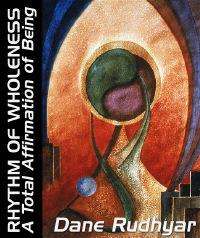 |
| Home | Bio | Art | Music | Literature | Civilization & Culture | Philosophy of Wholeness | Theosophy & Spirituality | Astrology |

RHYTHM OF WHOLENESS A Total Affirmation of Being by Dane Rudhyar, 1983 CONTENTS PROLOGUE PART ONE The Philosophy of Operative Wholeness 1. Prelude to a New Interpretation of Reality Page 1 Page 2 Page 3 Page 4 Page 5 Page 6 2. The Search for Spiritual Security: The One, the Whole, and Wholeness 3. The Movement of Wholeness PART TWO The Cycle of Being 4. The Structure of the Cycle of Being 5. The Four Crucial Phases of the Cycle of Being 6. The Inevitability of Success and Failure 7. Spirit and Mind PART THREE The Cycle of Man 8. Constitution of Man - The Physical and Psychic Bodies 9. Constitution of Man - The Spiritual Entity and the Higher Mind 10. The Structure and Transformation of the Total Person 11. The Cyclic Process of Spiritual Embodiment PART FOUR In The Spirit of Wholeness 12. The Principle of Holarchy and the Interplay of Horizontal and Vertical Relationships 13. Transpersonal Activity versus Mediumship 14. Rites of Passage EPILOGUE |

CHAPTER ONE
Prelude to a New Interpretation of Reality - 4 For Gautama Buddha, the tragedy in human existence was not merely death (or the birth-death syndrome, for his realization coincided with the birth of his son); it was the experience of "suffering" — or rather dukka. Dukka is not mere suffering but the devastating sense of being isolated as an individualized center of consciousness and of not belonging to one's society and culture — today we would say, of being alienated. The Buddha's intent in building his sangha was, I believe, to create an ideal community within which there would be no experience of isolation and in principle no suffering. All its members would have totally accepted the doctrine (the dharma) according to which the cycle of birth-suffering-death was caused by "ignorance" and could be transcended by the "knowledge" of the cycle of individual causes-effects-causes. Here again the key concept is transcendence; and it applied not merely to the sufferings of individual persons, but to social conditions like the caste-system, which produced dukka both for individuals and for entire classes of persons. Gautama was perhaps the first in historical times to think of social transformation not only in terms of the individual but in terms of humanity as a whole. However, this transformation was to be accomplished not by fighting against the social order (for instance, the caste-system) but by transcending it, by laying the foundations for a new type of community prefigured by the sangha. Presumably Jesus had a similar attitude. The ecclesia of the early Christians was a kind of sangha, perhaps inspired by Buddhist communities that had been established on the shore of the Dead Sea during the reign of the Buddhist emperor Asoka (273-232 B.C.). But while the essential commandment of Jesus was "Love ye one another as I have loved you," Gautama's doctrine, by explaining in causal terms the operations of change and the origin of dukka, was intended to make possible the overcoming of this suffering. The emphasis was upon the mind, but a mind no longer at the service of the individual self (especially in its aspect as the ego). Rather, mind became an instrumentality for transcending bondage to particular conditions of existence which, being particular and limited, engendered the dukka-producing feeling of tragic isolation. A great many human beings conceive of the events of their lives as if they happened by chance or at least with no significant relation to or within their lives as a whole. In a narrow, superficial sense, one action may be seen to lead to another, but this character of mere succession is fundamentally different from the Buddhist concept of karma — which the scientific term causality interprets only inadequately. Karma implies the cyclic nature of existence. Two events are not merely related as cause and effect; this relation acquires its full meaning as karma only when it is perceived and interpreted as affecting the whole of a life, and in a larger sense the whole of mankind. In Buddha's time, such an interpretation implied the development of a new mind — a truly objective mind; a mind not so much detached from existence as able to deal with wholes of existence, with patterns of changes in which every event tends to become its opposite; a mind able to perceive the entire sequence as a cyclic series assuming the symbolic form of a wheel (samsara). The poor and the rich, the weak and the powerful, represented opposite states; but those now poor would be rich at another time in the cycle, the slave would be a king — all according to the one universal principle of polarization and karma. Such an approach did not negate the mystic vision of the sages of preceding ages. It became necessary because the idealistic feeling of the identity of atman and Brahman becomes a tragic farce and a cause of acute dukka if an ego takes the place of atman. When this occurs, the process of individualization goes awry; it is deviated by being placed at the service of the emotions, the biological impulses, and an ego that gives these a particular cohesion. Such a cohesion increases and intensifies the sense of uniqueness and isolation. The vision of old sages preparing for death after a fully lived existence within a rigidly planned community can indeed turn sour when youngsters, filled with ambition and passion, try to experience such a vision through socially "prestigious" yoga exercises and spectacular deprivations. At the close of the twentieth century, we should be able to understand what happened two thousand five hundred years ago, because we have to deal with the far more complex and dukka-producing results of centuries of uncontrolled and one-pointed individualism combined with a materialistic, aggressive, and acquisitive approach to social togetherness and interpersonal relationships. Most significantly, Buddhism, in its various aspects is now openly accepted by a myriad of young people who in the late 1960s and early 70s either sought to rebel against society by stressing "their own" individual way of doing things, or sought freedom from collective patterns of interpersonal relationships and thinking by using psychedelic drugs. Buddhism offers them a traditional discipline which allows their restless, ego-centered individualism to gain some kind of collective support. Just as important, it offers a sense of security derived from beliefs and practices which have subsisted through social changes, political revolutions, and the pressures imposed by alien cultures and religions. Whether Gautama Buddha would approve of present-day Buddhism and its many schools, or Jesus of the multiplicity of Christian churches, is another matter. Basic principles retain their validity; but they lose their original impact of transformative newness. The rationalistic, clearly defined, and numbered precepts in Gautama's sutras — which were mostly secondhand restatements of remembered words he had uttered many years before — were as important in his psychotherapeutic and ethical approach as was the insistence of his contemporary, Pythagoras, on precise measurements of the lengths of string of his monochord when producing a succession of sounds.(4) The sixth century B.C. was the century when the measuring mind - the mind of reason, the analytical mind - began to give clearly defined forms to man's awareness of reality and his creative activities. But this new development was perhaps premature; it backfired into the absolute subjectivism of Sankaracharya(5) and the emotional bhakti movement of the Radha-Krishna cults, just as the rationalism of the classical age of Greece led to the irrationalism of and devotionalism of Christianity and the famous pronouncement of Tertullian, Credo quia absurdum (I believe because it is absurd). 4. See my book The Magic of Tone and the Art of Music (Shambhala Publications), 1982). Now free online at the Rudhyar Archival Project. Return 5. In spite of what Orientalists may think, the original Sankaracharya was born some thirty-three years after the death of Gautama. Clear proofs were given in an article by the southern Indian Brahmin, T. Subba Row, which first appeared between 1882 and 1889, and later was published in the book, A Collection of Esoteric Writings of T. Subba Row (Bombay, 1917). (A complete edition of this great man's writings and letters is now being compiled.) The Sankaracharya who lived between 788-820 or 850 A.D. revived a long tradition kept in mathas (monasteries): all the men who headed this school successively took the name Sankaracharya, as they still do today — hence the confusion. Return By permission of Leyla Rudhyar Hill Copyright © 1983 by Dane Rudhyar All Rights Reserved.  Web design and all data, text and graphics appearing on this site are protected by US and International Copyright and are not to be reproduced, distributed, circulated, offered for sale, or given away, in any form, by any means, electronic or conventional. See Notices for full copyright statement and conditions of use. Web design copyright © 2000-2004 by Michael R. Meyer. All Rights Reserved. |
 |